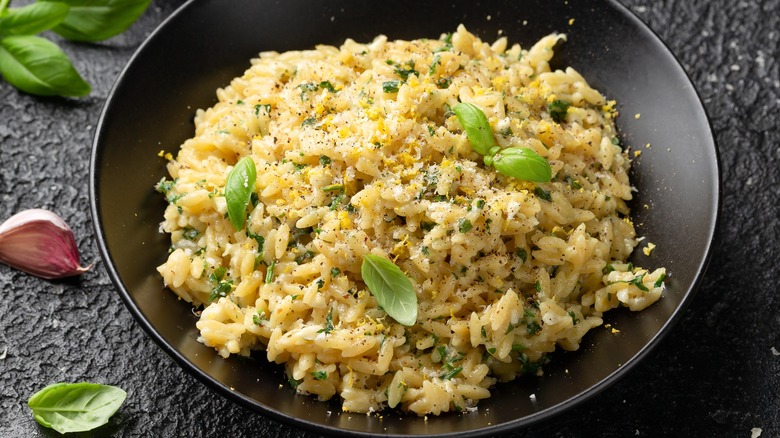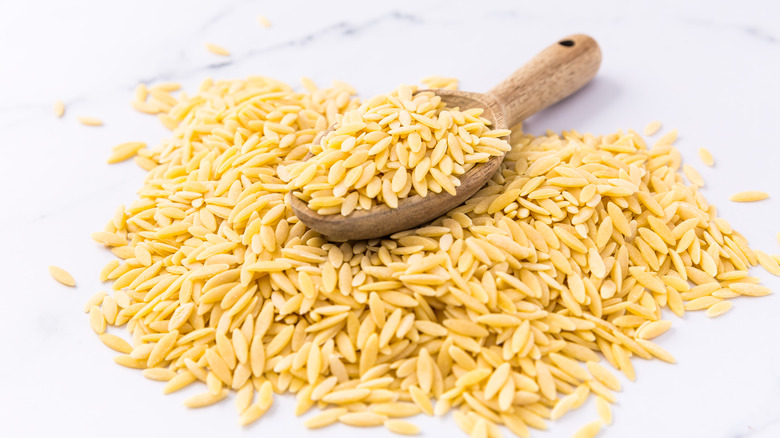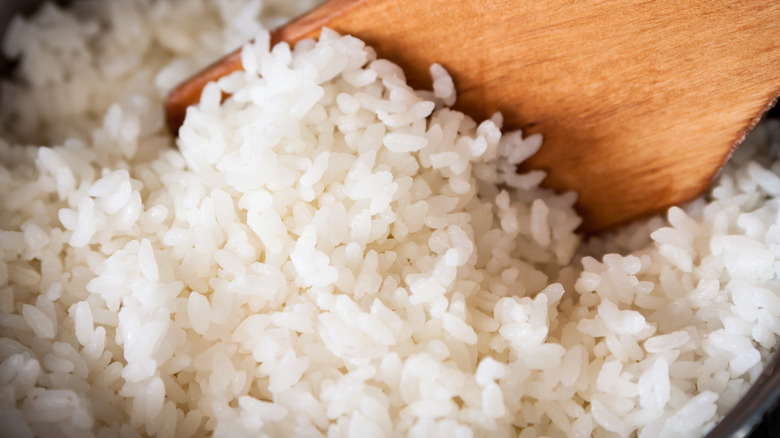The Difference Between Orzo Pasta And Rice
From fregola to acini de pepe, Italian cuisine encompasses varieties of pasta so small they're frequently mistaken for rice. One sort that often gets caught in the confusion is orzo. With a small, slender shape, it's easy to understand why the mistake happens, yet there are clear distinctions that separate the two foods.
Most prominently, orzo is made from wheat flour, while rice represents its own wheat-free class of cereal grain that grows as a grass. Orzo has a less starch-heavy consistency, which allows for a shorter cooking time. Its flavor is creamier, and it has a softer texture that integrates seamlessly into dishes. Meanwhile, the high starch content of rice makes it hold up better as a rigid vessel for flavors. Found in a large array of varieties, rice is used across continents for many applications. Typically, it's the arborio type of rice that's most frequently confused with orzo. This short-grained variety creates a delectable creamy risotto with a texture that can't quite be replicated. However, there's even more to unpack. Let's dive into the differences.
What is orzo pasta?
Like some varieties of couscous, orzo is made from ground golden semolina flour. Unlike rice, it contains gluten, although substitutes have now been manufactured. Its most similar counterparts are fregola, arborio rice, and Israeli couscous. It exists in several varieties, which can contain whole-grain flour and flavorings like sun-dried tomato and spinach.
The preparation technique is similar to other pastas; orzo is boiled in salted water, then drained. The cooking time is short, though; only around 8 to 10 minutes until it's al dente. However, unlike other pasta types, orzo can be prepared in a pilaf by adding it to stock and cooking in an oven for around 20 minutes until it absorbs the cooking liquid's flavor. Orzo is commonly enjoyed in soups and salads, or as a standalone dish with sauce. Some cooks use it as a substitute for risotto, but keep in mind that it yields a different texture. With a less starchy consistency than rice, it'll result in a chewier risotto.
Comparing rice preparation to orzo
Rice, the world's most popular food, comes in a dizzying array of sizes and colors. It is not made from wheat, and as a result, rice does not contain gluten and shares more qualities with grains like barley or farro. Long-grain rice types contain an abundance of amylose, a starch responsible for its granular texture. They require a longer cooking time than orzo, which will yield more separated grains once prepared. Such varieties — like common jasmine and basmati rice — are typically steamed; they'll do worse to mimic orzo since their mouthfeel is so different.
Short-grain rice is more similar to orzo. The starch content breaks apart in a different way, due to a high content of amylopectin, which causes it to lump together — such as in sticky rice or risotto. As such, it'll mimic orzo's creamy quality more, especially when slow-cooked in a liquid. Recipes for congee and other rice porridges call for cooking the grain for as long as 45 minutes to achieve such consistency. Even still, the rice granules will thicken in a manner that pasta won't, so try to keep rice and orzo applications separate.


